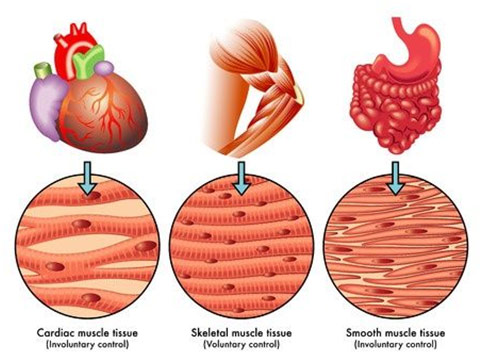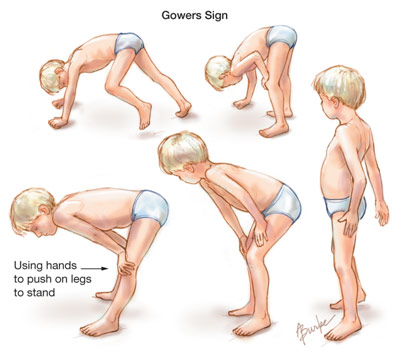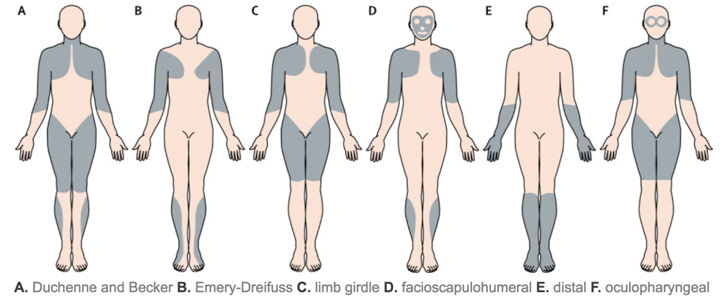Muscular dystrophy (MD) is a parent name for a group of genetic disease that lead to muscle weakness and a destruction of muscle mass. There are three major types of muscles—cardiac muscle, smooth muscle, and skeletal muscle. Controlled by the autonomic nervous system, the cardiac muscles unconsciously contract and relax to allow the heart to beat and pump blood throughout the whole body. Smooth muscles are also controlled by the autonomic system and involuntarily perform life-sustaining functions associated with many internal organs and systems like the digestive and reproductive systems among others. In contrast, skeletal muscles are controlled by the somatic nervous system and perform voluntary actions like flexion/extension, abduction/adduction, pronation/supination etc. They also are generally attached to bones by way of a tendon and go across a joint. Muscular dystrophy mostly affects skeletal muscles, but it also affects cardiac and smooth muscles as well.

Three Different Types of Muscle in the Human Body
The major type of muscular dystrophy is dystrophinopathies where there is a mutation in the dystrophin gene that provides scaffolding support from the membrane to the extracellular matrix outside the cell. This allows creatine kinase to escape the muscle cells and for calcium to enter, leading to cell atrophy. Because of the gene’s location on the X chromosome, muscular dystrophy is massively more common in boys than girls because boys only have one X chromosome while girls have two X chromosomes. If the boy has a defective copy, he has the disease, but a girl has the possibility of having both the defective and a functional copy, which means she does not express the disease. In Duchenne muscular dystrophy (DMD), mutations cause there to be no dystrophin present at all while in Becker muscular dystrophy (BMD), mutations cause there to be misshapen dystrophin. The former is traditionally more severe with symptoms presenting earlier in childhood while the latter’s symptoms tend to be milder and present later in life. However, both present similar symptoms since they are caused by similar pathways.
Duchenne muscular dystrophy generally sees patients have muscle weakness begin in the pelvic and shoulder region as well as the patient has calf pseudohypertrophy or enlarged calf muscles. Gower’s sign is another common characteristic where the patient has difficulty rising from a sitting or lying position, dependently relying on their arms since their lower limb muscles are weak. Clumsiness, frequent falls, and waddling gait are other common symptoms. A wheelchair may be necessary to help with movement as the disease progresses in the patient’s pre-teen and teenage years. Other conditions like scoliosis (lateral curving of the spine) and dilated cardiomyopathy (heart enlargement that reduces cardiac output) can also occur as complications of muscular dystrophy. Scoliosis usually accompanies the loss of ambulation (ability to walk independently) as the patient transitions to using a wheelchair and is thought to be caused by the progressive weakening of posterior skeletal muscles that allow for the rotation and sideways movement of the vertebrate. Scoliosis can also cause respiratory problems in the patient due to the spine causing distortion of the thoracic cavity and the diaphragm. Dilated cardiomyopathy occurs since the lack of dystrophin also affect cardiac muscle cells, allowing them to more easily become damaged and die, which can impair the heart’s function due to fibrosis (thickening of connective tissue). Arrhythmias (abnormal heart rhythm) can also result because of the fibrosis on the heart’s conduction system.

Gower’s Sign
There are seven other major forms of muscular dystrophy: myotonic, limb-girdle, facioscapulohumeral, congenital, oculopharyngeal, distal, Emery-Dreifuss, Myotonic dystrophy affects voluntary muscles in the face, neck, forearms, and lower legs with symptoms like delayed muscular relaxation and dysphagia (swallowing problems). Limb-girdle muscular dystrophy affects proximal muscles in the arms and legs, causing movement and shoulder problems. Facioscapulohumeral muscular dystrophy affects the muscles in the face, shoulders, and upper arms, causing symptoms like speaking problems and dysphagia. Congenital muscular dystrophy causes severe muscle weakness at birth and generally sees symptoms like intellectual disabilities and hypotonia (reduced muscle tone). Oculopharyngeal muscular dystrophy affects the muscles of the eyes and the throat, causing symptoms like droopy eyelids and dysphagia. Distal muscular dystrophy affects distal muscles in the forearms, lower legs, hands, and feet, causing symptoms like reduced mobility and motion of these limbs. Lastly, Emery-Dreifuss muscular dystrophy affects muscles in the upper arm and lower leg, causing symptoms like reduced motion and stiff joints.

Affected Muscles for 7 Different Types of Muscular Dystrophy
Diagnosis of Duchenne and Becker muscular dystrophy generally involves a physical examination to check for Gower’s sign and how the patient walks. Additionally, a blood test for creatine kinase, which, as mentioned before, leaks out of muscle cells in patients with muscular dystrophy, can help form the diagnosis. A muscle biopsy can also help determine if the disease is muscular dystrophy and not some other disorder by looking for the presence, concentration, and/or location of the dystrophin in the tissue. However, the gold standard for this diagnosis is genetic testing as the doctor can look for the presence of the dystrophin gene and if there are any mutations there. Treatment of muscular dystrophy is generally nonsurgical with physical therapy and braces helping to manage the symptoms. Anti-inflammatory medications like glucocorticoids can also help by slowing muscle degeneration and increasing strength, but they sometimes may not be prescribed due to their severe side effects. Beta-blockers, which work by making your heartbeat slower and less forcefully, and ACE inhibitors, which work by dilating vessels to reduce blood pressure, may be used to help with the dilated cardiomyopathy. Spinal fusion surgery may become necessary to stop scoliosis and its detrimental effect on the patient’s breathing. However, unfortunately, there is no cure for the disease right now.

Infographic on Duchenne Muscular Dystrophy
Muscular dystrophy is a serious debilitating illness that can cause numerous other serious complications, but it can be managed with proper treatment and therapy. The damage can be slowed down, and patients can live a more normal life. With enormous sums of dollars invested into the disease and with new gene therapies to, for example, replace dystrophin to treat Duchenne muscular dystrophy already here with Exondys 51, there is, and always will be, hope for a future cure.
REFERENCES
Blair, Dennis. The Different Types of Muscle Tissue. 7 Apr. 2017. Core Fitness and Nutrition, www.ftcollinspersonaltrainer.com/2017/04/different-types-muscle-tissue/. Accessed 5 Nov. 2018.
Burke, Alison. Gowers Sign. 14 Dec. 2011. JAMA Network, jamanetwork.com/journals/jama/fullarticle/1104723. Accessed 5 Nov. 2018.
“Duchenne & Becker Muscular Dystrophy – Causes, Symptoms, Treatment & Pathology.” Youtube, uploaded by Osmosis, 11 Aug. 2016, www.youtube.com/watch?v=DGOmN6rnsNk. Accessed 5 Nov. 2018.
Kamdar, Forum, and Daniel Garry. Duchenne Muscular Dystrophy: Pathogenesis and Therapies. ScienceDirect, 21 Nov. 2016, www.onlinejacc.org/content/accj/67/21/2533.full.pdf. Accessed 5 Nov. 2018.
—. “Dystrophin-Deficient Cardiomyopathy.” Journal of the American College of Cardiology, vol. 67, 21 Nov. 2016. ScienceDirect, www.onlinejacc.org/content/accj/67/21/2533.full.pdf. Accessed 5 Nov. 2018.
“Muscle.” Biology Dictionary, biologydictionary.net/muscle/. Accessed 5 Nov. 2018.
Muscles Affected in Muscular Dystrophy. Mar. 2013. ScienceDirect, www.sciencedirect.com/science/article/pii/S0140673612618972. Accessed 5 Nov. 2018.
“Muscular Dystrophy.” Ortho Info, orthoinfo.aaos.org/en/diseases–conditions/muscular-dystrophy/. Accessed 5 Nov. 2018.
Newman, Tim. “All about Muscular Dystrophy.” Medical News Today, 18 Dec. 2017, www.medicalnewstoday.com/articles/187618.php. Accessed 5 Nov. 2018.
Osmosis. Muscular Dystrophy. 11 Aug. 2016. Youtube, www.youtube.com/watch?v=DGOmN6rnsNk. Accessed 5 Nov. 2018.
“What Are the Types of Muscular Dystrophy?” NIH, www.nichd.nih.gov/health/topics/musculardys/conditioninfo/types. Accessed 5 Nov. 2018.
















I discovered your blog site on google and examine a couple of of your early posts. Continue to keep up the superb operate. I just additional up your RSS feed to my MSN News Reader. Seeking ahead to reading more from you afterward!?